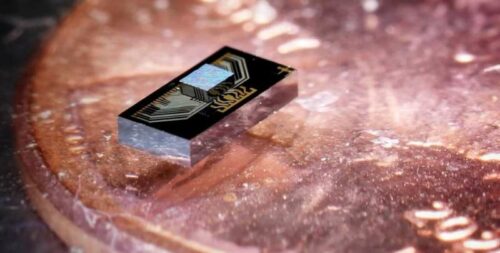- Scientists tackle the problem of ‘Computing Bottleneck’ (when a component reaches its limits) using photons to transfer data.
- Researchers develop a two-chip sandwich using an electronics chip integrated with a photonics chip to create a device that can transfer data at ultrahigh rates.

“There is a continuous demand for increasing the speed of data communication between different chips not only in data centers but also in high-performance computers. As the computing power of the chips scale, the communication speed can become the bottleneck, especially under stringent energy constraints,” says Azita Emami, the Andrew and Peggy Cherng Professor of Electrical Engineering and Medical Engineering; executive officer for electrical engineering; and senior author of the paper.
To tackle this problem, researchers at Caltech and University of Southampton in England designed an electronics chip integrated with a photonics chip (uses light to transfer data). This device is optimized to work together and is capable of transmitting data at ultrahigh speed. This device is, in future, can be adapted to high grade server rooms and data centers.
Data centers nowadays are built underwater as they work and need to be cooled. And if the device is built better, it can transfer more data and generate less heat. As the data processing is mostly done on electronics and the transmission does not necessarily require electronics(for eg., fiber optic communication), we can introduce a photonics concept here and process data transmission using photonics.
The process, from the initial idea to the final test in the lab, took four years to complete, with every design choice impacting both chips. “We had to optimize the entire system all at the same time, which enabled achieving a superior power efficiency,” Hashemi says. “These two chips are literally made for each other, integrated into one another in three dimensions.”
The resulting optimized interface between the two chips allows them to transmit 100 gigabits of data per second while producing just 2.4 pico-Joules per transmitted bit. This improves the electro-optical power efficiency of the transmission by a factor of 3.6 compared to the current state-of-the-art. A picojoule is one-trillionth of a Joule, which is defined as the energy released in one second by a current of 1 ampere through a resistance of 1 ohm—or about 0.24 calories.
References : Arian Hashemi Talkhooncheh et al, A 100-Gb/s PAM4 Optical Transmitter in a 3-D-Integrated SiPh-CMOS Platform Using Segmented MOSCAP Modulators, IEEE Journal of Solid-State Circuits (2022). DOI: 10.1109/JSSC.2022.3210906





